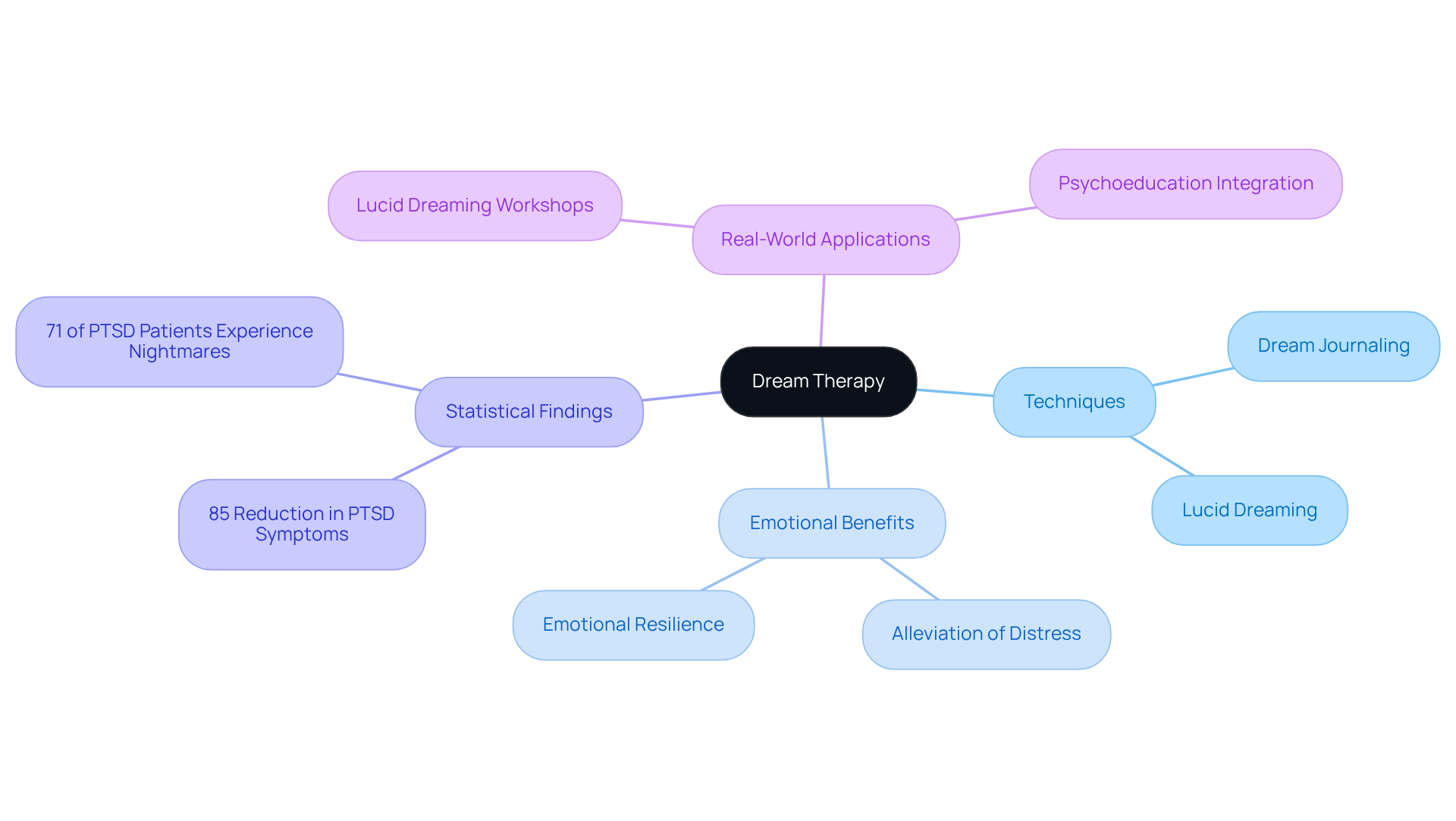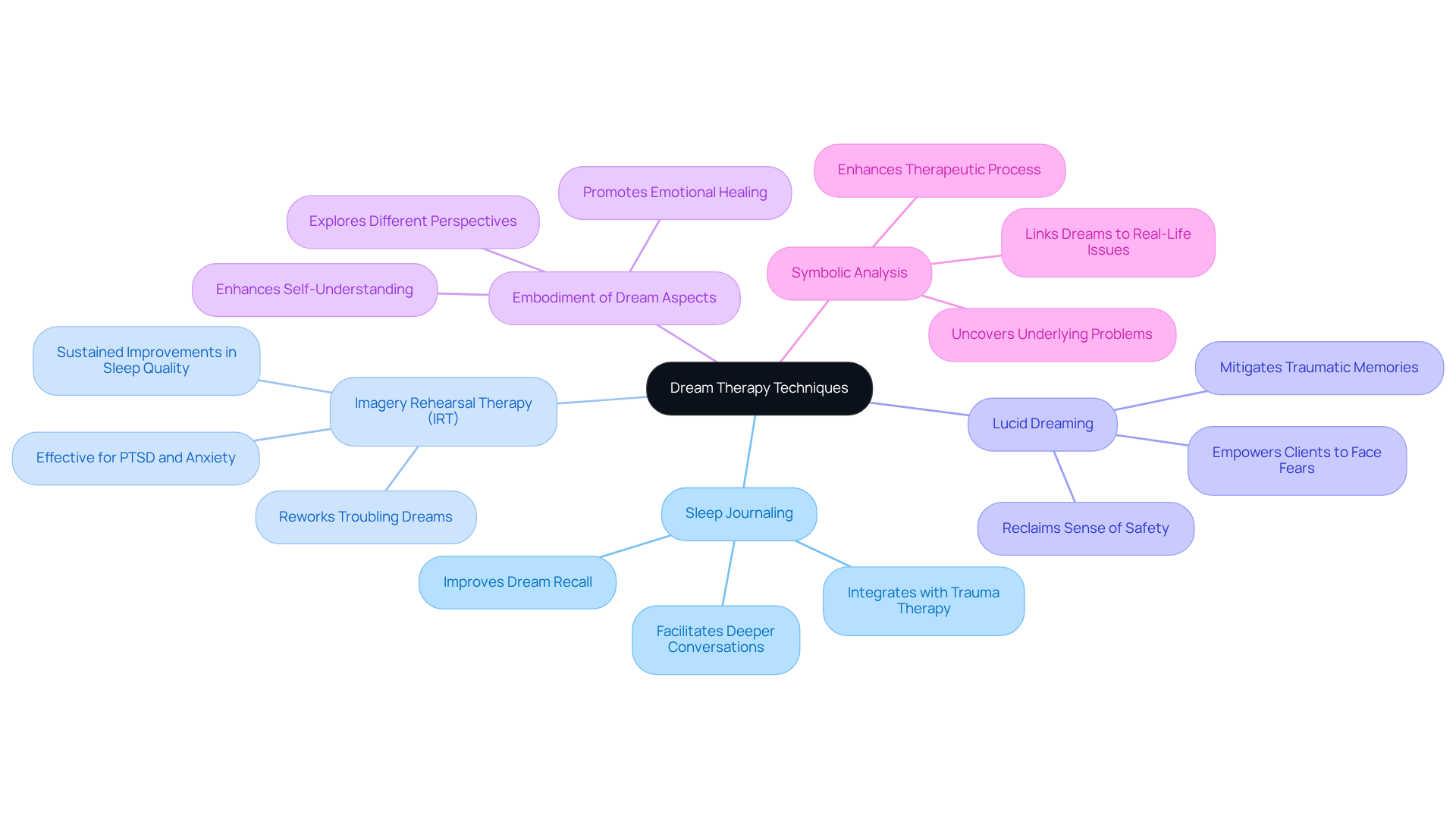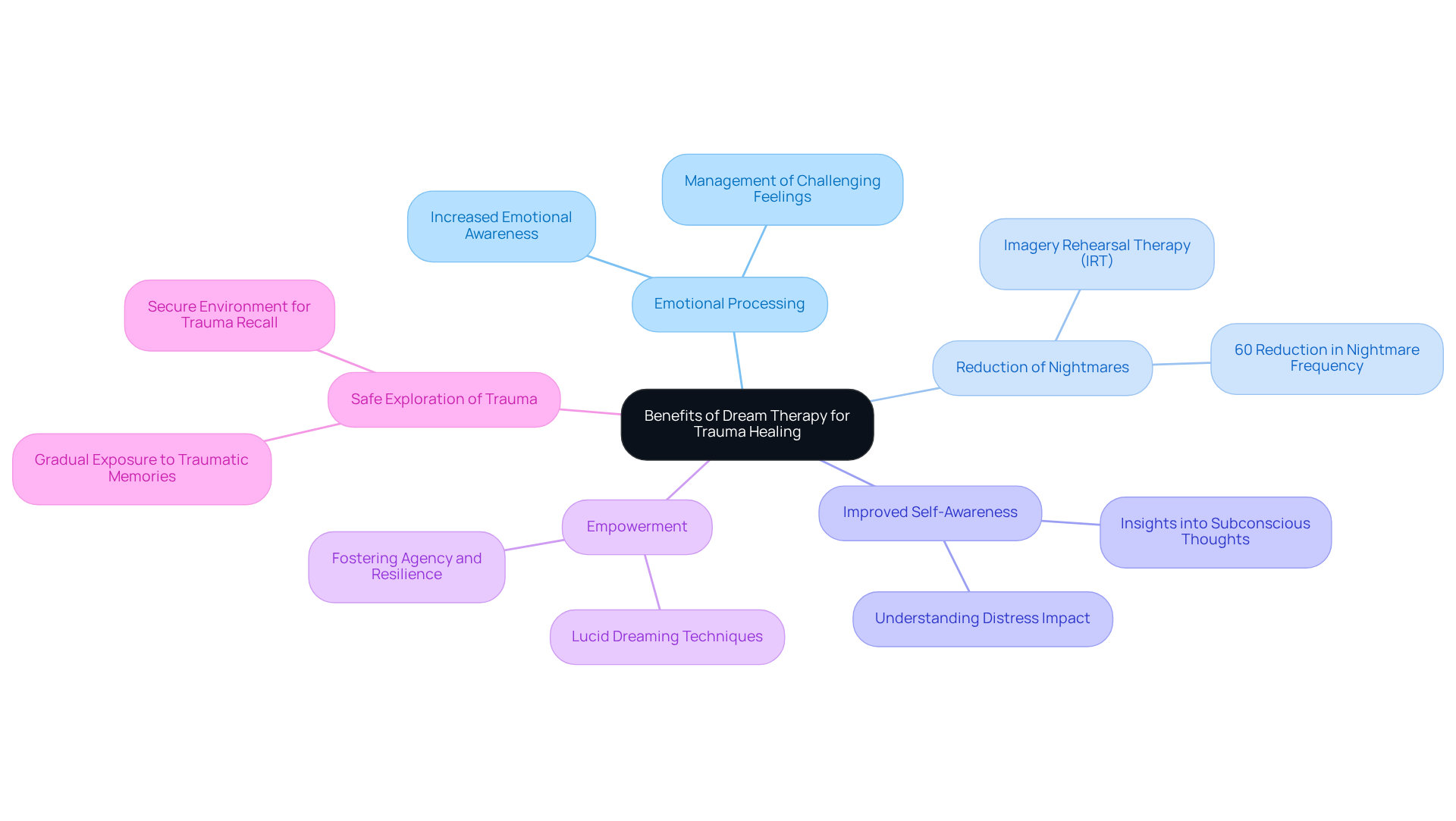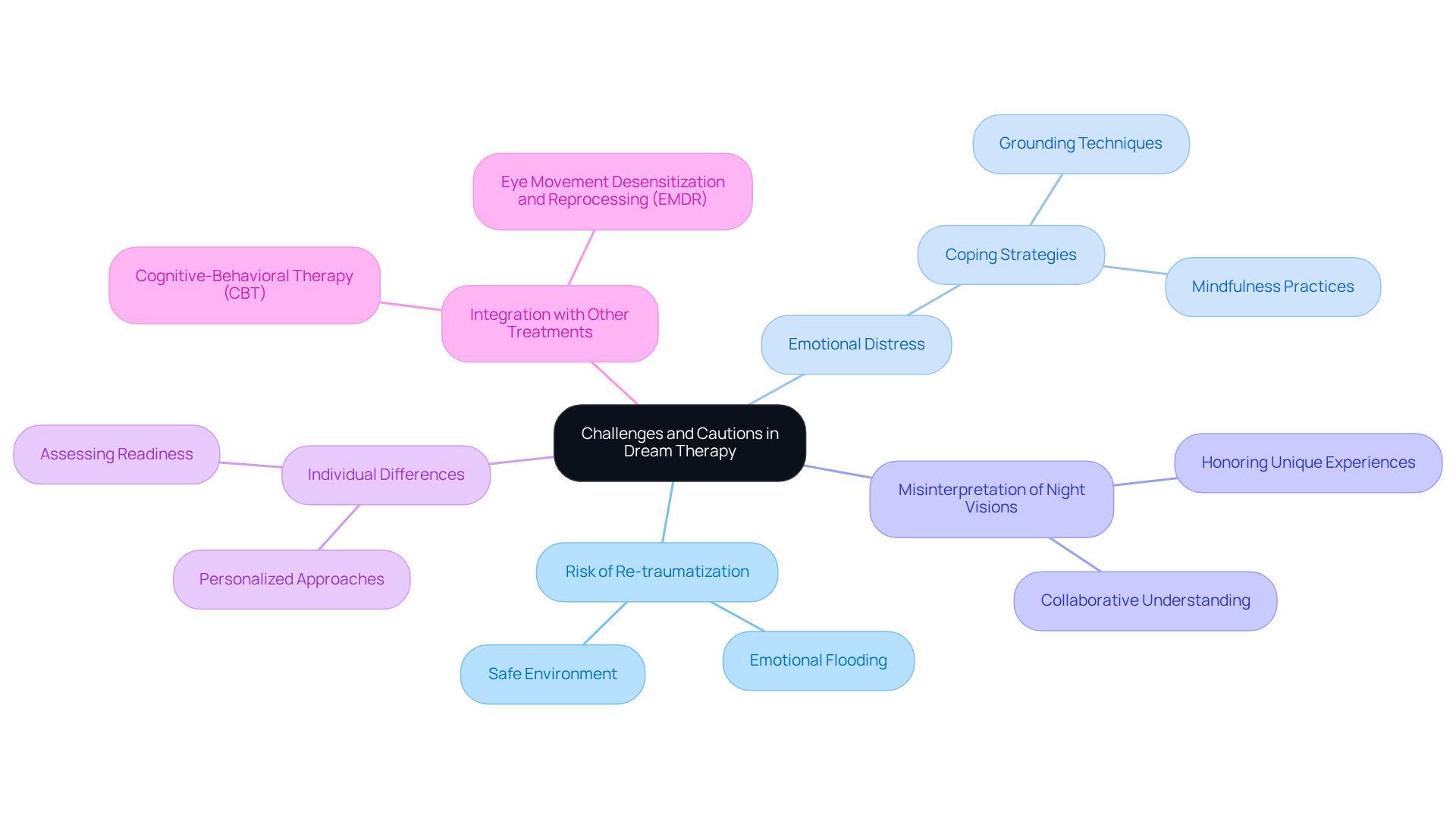Overview
The four essential steps in dream therapy for trauma healing—sleep journaling, imagery rehearsal therapy, lucid dreaming, and dream analysis—offer powerful techniques that facilitate emotional processing and empowerment.
Have you ever felt overwhelmed by your past? These methods provide a safe environment for individuals to confront and integrate traumatic experiences, ultimately leading to reduced nightmares and improved emotional resilience.
As we explore this further, consider how these compassionate approaches can guide you on your healing journey, allowing you to reclaim your peace and well-being.
Introduction
Dream therapy emerges as a transformative approach to healing trauma, offering a unique lens through which individuals can explore their subconscious fears and experiences. Have you ever felt overwhelmed by your past? By engaging with their dreams, individuals can uncover hidden emotions and insights, paving the way for profound recovery.
However, as we navigate this therapeutic landscape, essential questions arise about the effectiveness and safety of such methods:
- What are the critical steps to harnessing the power of dreams for healing?
- How can one navigate the potential challenges that arise along the way?
Together, we can explore these questions and embark on a journey towards healing.
Explore the Fundamentals of Dream Therapy
Dream therapy is a therapeutic method that gently invites individuals to explore and interpret their nocturnal visions as a means to promote healing from trauma. This compassionate approach is rooted in the understanding that dream therapy can reveal our deepest thoughts, fears, and experiences, often providing insights that may elude us during our waking hours. By engaging with dreams in dream therapy, individuals have the opportunity to confront and process traumatic memories in a safe and nurturing environment.
At The Emerald Couch, we are dedicated to providing personalized therapy solutions that cater to the unique needs of each individual. Our approach ensures that everyone receives the essential support necessary for their journey towards recovery from trauma and anxiety. Key techniques in dream therapy, such as dream journaling, encourage individuals to document their dreams immediately upon waking. This practice is followed by thoughtful discussions with a therapist to analyze the emotions and content linked to those dreams. Such exploration can illuminate feelings and experiences, ultimately aiding in the recovery process.
Recent studies highlight the effectiveness of oneirotherapy in alleviating emotional distress. For example, a pilot study on lucid dreaming found that 85% of participants experienced significant reductions in PTSD symptoms, with many reporting a complete cessation of nightmares. This suggests that dream therapy not only alleviates distress but also fosters emotional resilience through engagement with dreams. Notably, up to 71% of individuals diagnosed with PTSD frequently experience nightmares, highlighting the importance of addressing these challenges through dream therapy.
Real-world applications of dream therapy have yielded promising results. Participants in lucid dreaming workshops have reported noticeable decreases in negative emotions and an overall improvement in well-being, indicating that transforming nightmares can lead to profound healing. Additionally, integrating psychoeducation within therapy has been shown to diminish the distress associated with nightmares, empowering clients to manage their experiences more effectively.
Psychologists emphasize the significance of engaging with visions in the recovery from distress, noting that dream therapy can facilitate emotional relief and integration. As Charlie Morley, a British lucid dreaming instructor, beautifully stated, "To become fully aware within a nightmare and recognize that it is merely a fabrication is a deeply empowering experience, leading to intense feelings of relief and allowing the underlying psychological distress to be released and integrated."
By incorporating dream therapy methods into the healing journey, individuals can harness the potential of their subconscious experiences to navigate their recovery more effectively, supported by the personalized services at The Emerald Couch. We warmly invite you to take the first step towards healing by scheduling a free 30-minute consultation with us. Feel free to reach out at info@emeraldcouch.com or call (720) 707-1383 to learn more about our tailored treatment plans and how we can assist you on your journey to wellness.

Implement Key Techniques in Dream Therapy
Several key techniques are commonly employed in dream therapy to promote healing, particularly for individuals dealing with trauma and anxiety. Have you ever felt overwhelmed by your past? These approaches may offer you a pathway to understanding and relief.
-
Sleep Journaling: Imagine waking up and capturing the essence of your dreams right away. Clients are encouraged to record their visions promptly upon waking. This practice not only improves recall of dreams but also encourages deeper contemplation during counseling sessions. It facilitates more significant conversations about the emotional elements of dreams. At The Emerald Couch, dream therapy is often integrated with trauma-focused therapy to help clients process their experiences more effectively.
-
This technique, known as dream therapy, invites clients to rework the storyline of troubling dreams or nightmares. By envisioning a more favorable outcome and rehearsing this new scenario, clients often find relief. Research indicates that IRT can lead to sustained improvements in sleep quality and PTSD symptoms, making it a valuable tool in trauma recovery, particularly for those dealing with OCD and anxiety disorders.
-
Lucid Dreaming: Clients learn to recognize when they are in a state of sleep, empowering them to face fears or change the direction of their experiences. This newfound control can help mitigate the impact of traumatic memories, providing a therapeutic avenue for processing distressing experiences using dream therapy. The Emerald Couch highlights the significance of this technique in assisting individuals to reclaim a sense of safety and agency in their lives.
-
In this method of dream therapy, individuals are encouraged to embody different aspects of their dreams, exploring various perspectives and feelings linked to the dream content. This technique fosters a deeper understanding of the self and the issues at hand, promoting emotional healing and insight. By combining this approach with cognitive processing treatment (CPT) and dream therapy, individuals at The Emerald Couch can tackle trauma comprehensively.
-
In dream therapy, therapists help individuals understand the symbols and themes present in their nighttime visions, linking them to real-life experiences and feelings. This analysis can uncover underlying issues that may need to be addressed in therapy, enhancing the overall therapeutic process. At The Emerald Couch, this technique is particularly useful for individuals struggling with compulsions and anxiety, as it helps them connect their dream experiences to their daily challenges.
By integrating these techniques, clients can manage their distress more effectively, resulting in enhanced mental health outcomes and a greater sense of tranquility. If you feel ready to explore these healing methods, please reach out to us at info@emeraldcouch.com or call (720) 707-1383. Your journey towards healing is important, and we are here to support you.

Understand the Benefits of Dream Therapy for Trauma Healing
Dream therapy provides numerous benefits for individuals healing from trauma, especially for those seeking specialized support at The Emerald Couch.
-
Emotional Processing: Have you ever felt overwhelmed by your past? Interacting with subconscious experiences allows individuals to face and manage feelings that might be challenging to reach during waking hours. This process can lead to increased emotional awareness and control, which is vital for those recovering from distress while navigating their emotions.
-
Reduction of Nightmares: Techniques like Imagery Rehearsal Therapy (IRT) have been shown to significantly reduce the frequency and intensity of nightmares, common in individuals with PTSD and other trauma-related disorders. Studies indicate that IRT can lead to a reduction in nightmare frequency by up to 60%, providing relief for those suffering from trauma-related sleep disturbances. Notably, the prevalence of posttraumatic nightmares in patients with PTSD can be as high as 72%.
-
Improved Self-Awareness: By examining nocturnal visions, individuals can gain insights into their subconscious thoughts and emotions, resulting in a deeper understanding of their distress and its impact on their lives. This self-awareness is crucial for effective healing and recovery.
-
Empowerment: Techniques like lucid dreaming can enable clients to take charge of their experiences, fostering a sense of agency and resilience in the face of trauma. This empowerment is particularly beneficial for overachievers who may struggle with burnout and anxiety.
-
Safe Exploration of Trauma: Dream treatment provides a secure environment for individuals to explore traumatic memories without the intense emotional turmoil that may arise when recalling these experiences in waking life. This approach can facilitate gradual exposure and integration of traumatic memories into their narrative, aligning with the tailored therapeutic approach at The Emerald Couch, where dream therapy services are customized to meet individual needs.
If you are curious about exploring sleep treatment and its advantages, please reach out to us at The Emerald Couch. You can contact us via email at info@emeraldcouch.com or call us at (720) 707-1383. We offer a free 30-minute consultation to help you understand your needs and how we can assist you. Please note that we are considered an out-of-network provider for most insurance companies, so you will need to pay upfront for your session and may seek reimbursement from your insurance provider. We are here to support you on your journey to healing.

Navigate Challenges and Cautions in Dream Therapy
While dream therapy is a powerful tool for healing, it is essential to navigate its challenges and cautions.
-
Risk of Re-traumatization: Have you ever felt overwhelmed by your past? Engaging deeply with traumatic dreams can lead to emotional flooding or re-traumatization. At The Emerald Couch, our therapists prioritize creating a safe environment, proceeding at a pace that aligns with your comfort level. This careful approach is vital to prevent exacerbating trauma symptoms, ensuring you feel supported throughout your journey.
-
Emotional Distress: Discussing troubling experiences during sleep may evoke strong feelings, which can be overwhelming. It’s important to be prepared for this possibility and equipped with coping strategies, such as grounding techniques or mindfulness practices, to manage your emotional responses effectively. Remember, these strategies are part of the comprehensive treatment options available at The Emerald Couch, designed to nurture your healing process.
-
Misinterpretation of Night Visions: The personal nature of night visions can lead to misinterpretation, resulting in confusion or distress. Our therapists at The Emerald Couch assist you in a manner that honors your unique experiences and interpretations, fostering a collaborative understanding of the subconscious content. We are here to help you navigate these complex feelings with care and empathy.
-
Individual Differences: Reactions to dream treatment can differ greatly among people. While some may find it beneficial, others might feel uncomfortable or unhelpful. Assessing your readiness and willingness to engage with dream therapy is crucial for effective treatment. For instance, Andy's story illustrates the profound impact of nightmares on daily life, highlighting the need for personalized approaches that resonate with your individual journey.
-
Integration with Other Treatments: Dream work should not be considered a standalone intervention. Its effectiveness is enhanced when integrated with other therapeutic modalities, such as cognitive-behavioral therapy or EMDR, addressing the multifaceted nature of trauma and ensuring comprehensive care. Notably, a study found that 73% of participants did not meet PTSD diagnosis criteria post-treatment, demonstrating the potential effectiveness of a well-rounded therapeutic approach. Together, we can explore the best path for your healing.

Conclusion
Engaging in dream therapy opens a compassionate pathway for individuals seeking to heal from trauma. This therapeutic approach leverages the power of dreams to unlock deep-seated emotions and experiences, allowing for the exploration and processing of traumatic memories in a safe environment. By utilizing techniques such as dream journaling, lucid dreaming, and imagery rehearsal therapy, individuals can confront their fears, gain emotional resilience, and navigate their healing journey more effectively.
Have you ever felt overwhelmed by your past? Throughout this article, we’ve highlighted the numerous benefits of dream therapy, including:
- Emotional processing
- Reduction of nightmares
- Improved self-awareness
- A sense of empowerment
Real-world applications demonstrate promising outcomes, with studies indicating significant reductions in PTSD symptoms and emotional distress among participants. The importance of personalized therapy solutions at The Emerald Couch is underscored, ensuring that each individual receives the support tailored to their unique needs.
Ultimately, dream therapy serves as a vital tool for trauma recovery, encouraging individuals to harness the potential of their subconscious experiences. By integrating dream therapy with other therapeutic modalities, individuals can achieve a comprehensive approach to healing. Embracing this journey can lead to profound transformations, inviting those affected by trauma to take the first step towards a brighter, more empowered future.
Frequently Asked Questions
What is dream therapy?
Dream therapy is a therapeutic method that encourages individuals to explore and interpret their dreams to promote healing from trauma. It helps reveal deep thoughts, fears, and experiences, providing insights that may be missed during waking hours.
How does dream therapy help with trauma and anxiety?
Dream therapy allows individuals to confront and process traumatic memories in a safe environment, ultimately aiding in their recovery from trauma and anxiety.
What techniques are commonly used in dream therapy?
Key techniques include dream journaling, where individuals document their dreams upon waking, followed by discussions with a therapist to analyze the emotions and content linked to those dreams.
What does research say about the effectiveness of dream therapy?
Recent studies show that dream therapy, particularly oneirotherapy, can alleviate emotional distress. For instance, a pilot study on lucid dreaming found that 85% of participants experienced significant reductions in PTSD symptoms.
How do nightmares relate to PTSD and dream therapy?
Up to 71% of individuals diagnosed with PTSD frequently experience nightmares. Dream therapy addresses these challenges, helping individuals manage and reduce the distress associated with nightmares.
What are the real-world applications of dream therapy?
Participants in lucid dreaming workshops have reported decreases in negative emotions and improved well-being, indicating that transforming nightmares can lead to profound healing.
What role does psychoeducation play in dream therapy?
Integrating psychoeducation within therapy helps diminish the distress associated with nightmares, empowering clients to manage their experiences more effectively.
Who can benefit from dream therapy?
Individuals dealing with trauma, anxiety, or distress related to their dreams can benefit from dream therapy, as it facilitates emotional relief and integration.
How can someone start dream therapy at The Emerald Couch?
Interested individuals can schedule a free 30-minute consultation by reaching out via email at info@emeraldcouch.com or calling (720) 707-1383 to learn more about tailored treatment plans.




